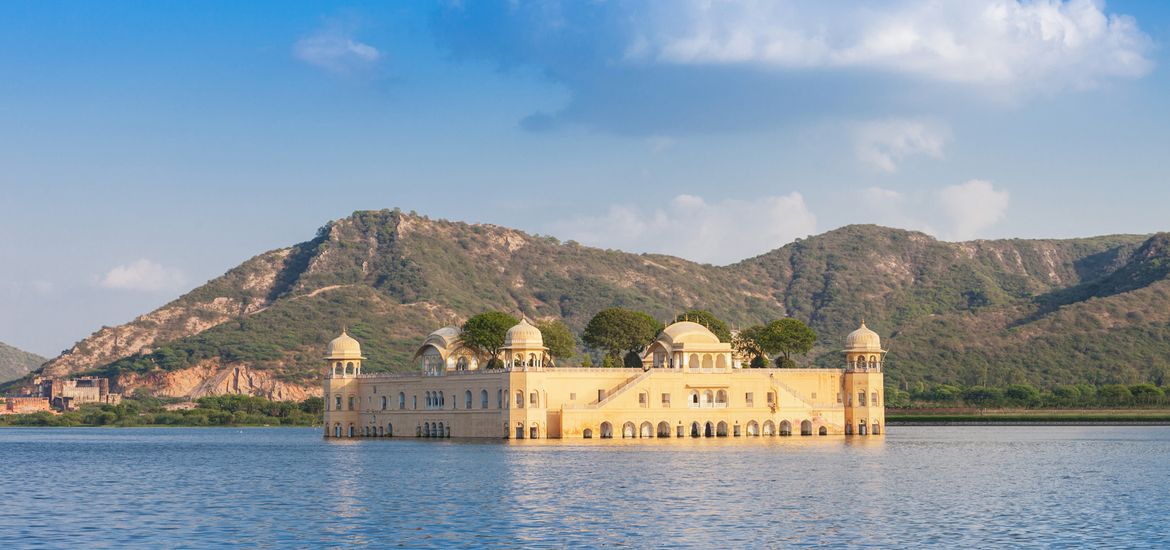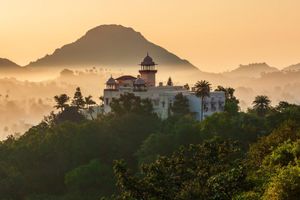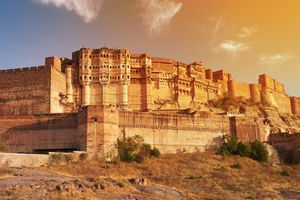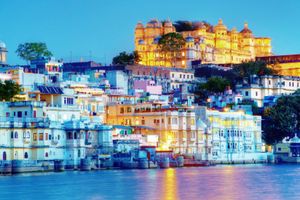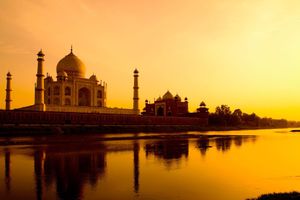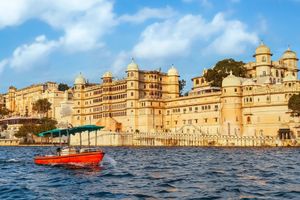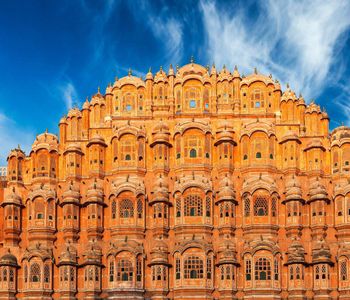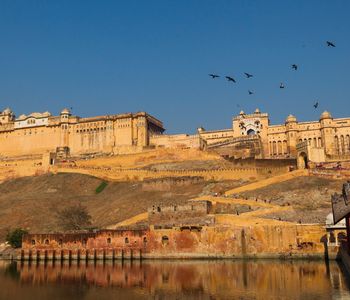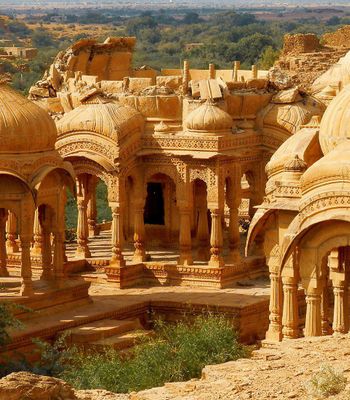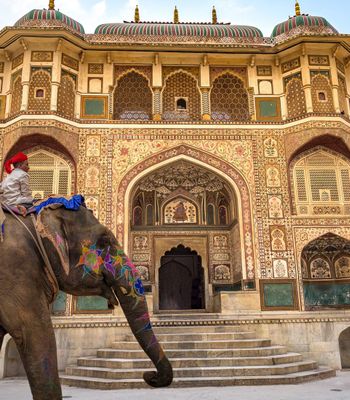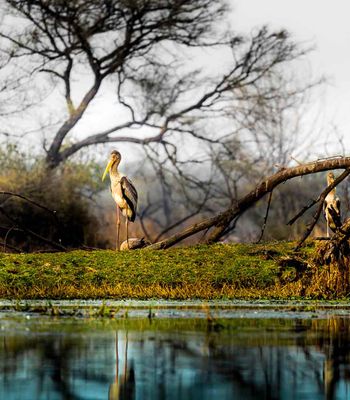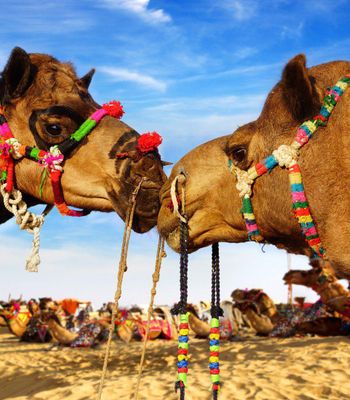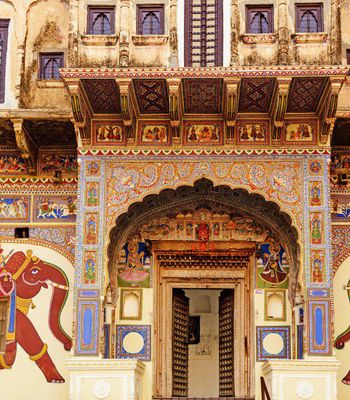Located northeast of Jaipur, India, Jal Mahal is a floating palace in Man Sagar Lake. Its distinct architecture and fascinating history make this red sandstone structure a favorite destination for travelers visiting the Rajasthan region. Dive into the culture, design and conservation of Jal Mahal for an unforgettable experience.
Exploring the Rich History
The Jal Mahal, or “Water Palace,” was built around 1699 by Maharaja Madho Singh I. However, Maharaja Jai Singh II of Amber significantly expanded the property when he came to power in the early 1700s. Subsequently, elaborate renovations became a hallmark of Jal Mahal, ushering in Jaipur’s royal era. During the palace’s prime, it was used as a royal retreat, where hunting and other recreational activities attracted the upper class during the fall and winter.
Sadly, the palace fell into disrepair over time. In the early 2000s, the Rajasthan Tourism Development Corporation, along with investors and government agencies, worked to restore the palace. Today, it stands as a testament to the region’s royal heritage, maintained regularly as part of Jaipur’s cultural identity.
Understanding the Submerged Aesthetic
Although Jal Mahal appears to float, it has a solid foundation beneath the water. If the lake were drained, the palace would reveal its five-story structure. When the lake is full, however, only one story remains visible above the surface. The lower levels have suffered significant damage from water exposure, which is why the palace interior is closed to the public. Also, reducing foot traffic into the landmark is a simple way to preserve the structure as natural weathering impacts the materials.
In earlier times, visitors could take gondolas to the palace, but preservation of both the structure and lake now takes priority. As a result, viewing Jal Mahal from the shoreline is the only way to experience this remarkable landmark today.
Learning About the Architecture
The palace’s architecture combines Rajput and Mughal styles, which were popular throughout 18th-century Rajasthan. Jal Mahal features four chhatris, or octagonal domes, marking the corners, and a Bengali-style dome crowning the terrace center. Constructed primarily from red sandstone, the palace’s color contrasts beautifully with the deep blue of the lake, which is a striking sight in the “Pink City” of Jaipur.
In addition, intricate carvings embellish the palace’s exterior. Zoom in closely with your camera or phone to admire these delicate designs, which hold historical and artistic significance. For example, you might spot jali screens or latticework screens across the palace's exterior walls.
Discovering Man Sagar Lake and Its Surroundings
A large viewing area along the shoreline offers visitors panoramic views of Jal Mahal. Here, people gather to take photos from multiple angles, often at the site’s popular “selfie point.” Statues and small monuments along the shore add to the area’s charm.
Because the site attracts many tourists, the promenade is lined with local vendors selling Rajasthani jewelry, textiles and handcrafted items. These experiences give visitors a chance to enjoy the region’s artistry while gaining spectacular views of the palace.
Diving Into the Site’s Conservation Challenges
For many years, natural runoff and untreated sewage polluted Man Sagar Lake, driving away native birds and wildlife. As environmental awareness grew, the government and private partners launched a major restoration project in the early 2000s.
For example, crews dredged silt and removed contaminants, redirected harmful runoff away from the lake and reconstructed wetland areas along the shoreline to act as natural filters. These efforts revived the lake’s health and allowed migratory birds such as cormorants, grey herons, and kingfishers to return.
In addition, the palace’s exterior is routinely cleaned to prevent debris and pollutants from seeping into the water. Ongoing maintenance reflects how Jaipur’s residents and authorities value both nature and heritage, ensuring that tourism supports conservation rather than harms it. Currently, the lake is the cleanest it has been in generations.
Knowing How to View Jal Mahal
The best time to visit Jal Mahal is between October and March, when the weather is cool and the sunlight casts a golden glow on the red sandstone. The shoreline area is open from 6 a.m. to 6 p.m., allowing visitors to spend the day photographing, birdwatching or simply relaxing.
A walk around the lake reveals new viewing angles and a peaceful escape from crowds. Wear comfortable shoes for this lengthy walk, however. With no entry fee, Jal Mahal remains a popular stop for budget-conscious travelers exploring Jaipur.
Traveling to Man Sagar Lake
Most visitors stay in Jaipur city, located about 2.5 miles south of Man Sagar Lake along Amer Road. The easiest ways to reach Jal Mahal are by taxi, rideshare or bus. The nearest bus stop is Shahpura Bagh. Because of the palace's popularity, regular bus trips to the site are commonplace.
For travelers coming from other parts of India, the Jaipur–Delhi National Highway runs close to the site. Tourists from Delhi and Mumbai often plan weekend trips to explore Jal Mahal and nearby attractions such as Amber Fort and Nahargarh Fort. Truthfully, creating an itinerary for a weekend getaway or a week-long adventure is possible with the landmarks in this region.
Getting to Know the Palace’s Cultural Impact
Known as the “Land of Palaces,” Rajasthan finds one of its finest symbols in Jal Mahal. The palace’s royal past and natural setting express the traditional balance between luxury and respect for the environment. This harmony mirrors today’s sustainability efforts while preserving the site’s historic grandeur.
Water holds deep meaning in Indian culture, symbolizing purity, life and renewal. By situating the palace within the lake, Jaipur’s rulers created a structure that embodies spiritual duality, which is the coexistence of human artistry and natural serenity.
With nearly 800,000 visitors each year, Jal Mahal remains a top destination for its historical, philosophical, and aesthetic appeal.
Today, it stands not only as an architectural gem but also as a symbol of cultural revival and environmental renewal. Whether you visit for photography, history or quiet reflection, Jal Mahal continues to inspire awe as Jaipur’s floating masterpiece.
